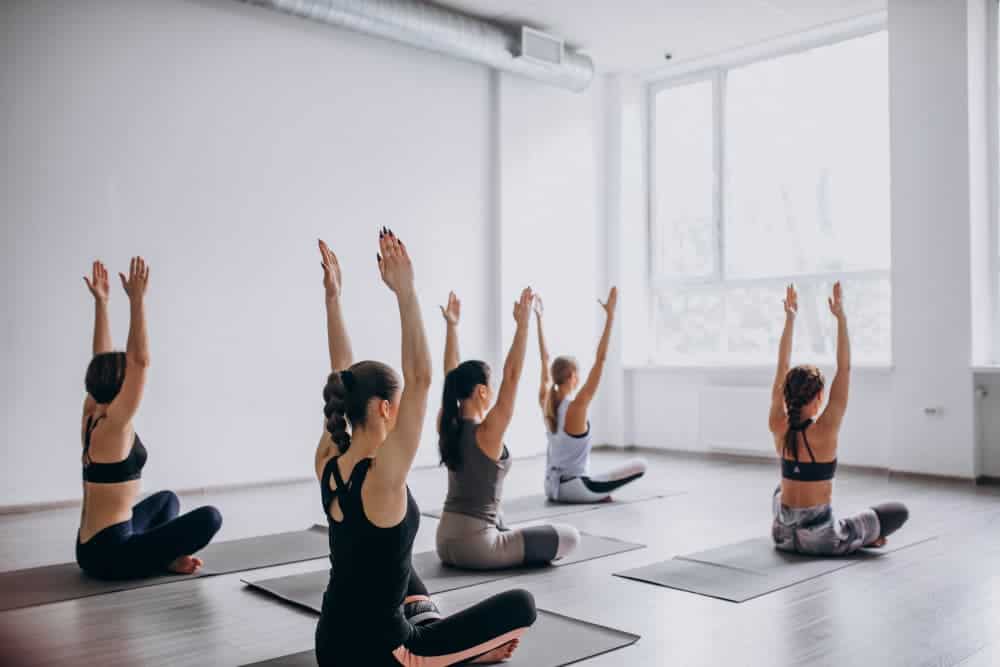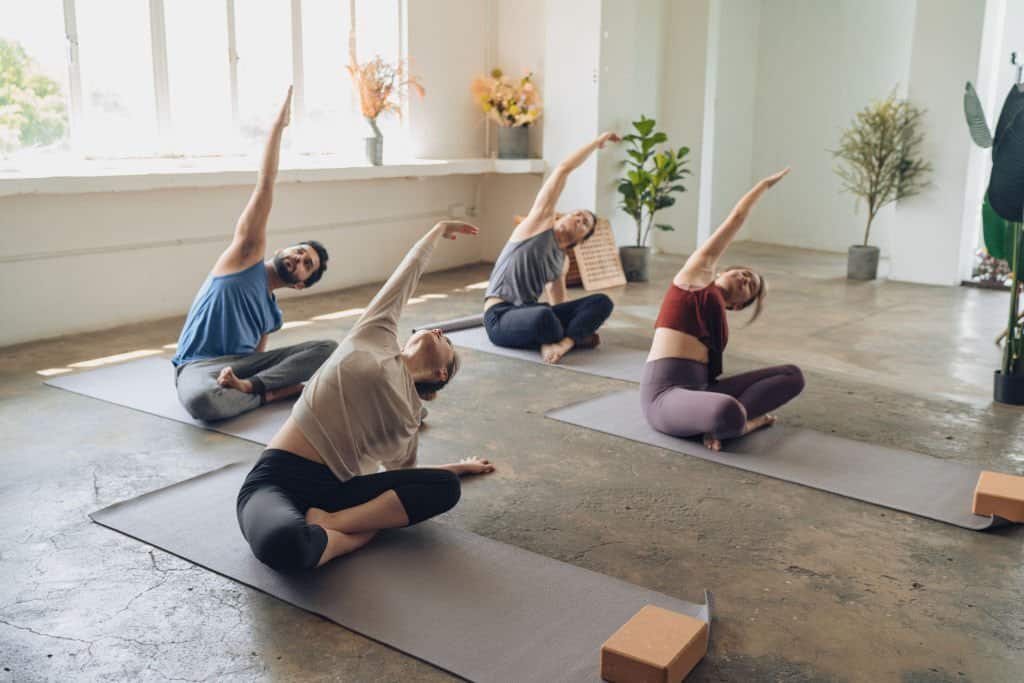
The benefits of yoga are well-documented, and there is a growing body of scientific evidence to support its efficacy. Yoga can improve flexibility, strength, and endurance and reduce stress levels and promote relaxation. Regular yoga practice provides both physical and mental health benefits.
For many people, the physical benefits of yoga are enough to justify a regular practice. However, the mental and emotional benefits of yoga should not be underestimated. Yoga can help to still the mind and quiet anxious thoughts. It can also foster a sense of composure and calmness.
In an increasingly chaotic world, the ability to find inner peace and calm is more valuable than ever. Maintaining a regular yoga practice can provide substantial physical, mental, and emotional benefits for all these reasons.
What is Yoga?

Yoga is an ancient Indian practice that has been around for 5,000 years. “Yoga” derives from the Sanskrit term “yuj,” which means to join or incorporate. It is a system of techniques designed to align your body, mind, and spirit.
The basic goal of yoga is to achieve union (integration) of the individual Self with the universal Self. It can be accomplished through various techniques, including postures (asanas), breathwork (pranayama), and meditation. Yoga is a highly personal practice, and there are many different styles and schools of yoga.
Yoga Types:
There are many different types of yoga, each with its focus and benefits. However, all yoga styles share common elements, including breath work and postures.
Components of yoga:
Yoga postures are one of the key components of any yoga practice. Each pose has specific benefits and can help to improve your flexibility, strength, balance, and stamina.
Breathing exercises are another important part of yoga. Proper breathing helps improve your concentration and can also help to reduce stress levels. In yoga, we use a special type of breath called “pranayama.” Pranayama involves controlling the breath to achieve specific effects.
Hatha, A Popular type of yoga:
Hatha Yoga is one of the most popular. It is a more physical type of yoga that combines many styles. Hatha yoga is centered on pranayama or breath-controlled exercises. These are followed by a series of asanas or yoga postures. The asanas are designed to stretch and strengthen the body.
The final pose, savasana, is a resting pose that allows the body to absorb the benefits of the previous poses. Hatha yoga is an excellent way to improve flexibility and strength and calm and focus the mind.
So let’s start discussing how yoga is beneficial for you.
Physical benefits of yoga:
1. Increased flexibility:
There are many physical health benefits of yoga, but one of the most important is increased flexibility. When you Regularly practice yoga regularly, your muscles become more flexible and elastic. It makes you less likely to injure yourself during physical activity and makes it easier to perform everyday tasks like reaching for a can on a top shelf or bending down to tie your shoes.
In addition, increased flexibility can lead to improved posture and help alleviate back pain. Whether you’re a professional athlete or a couch potato, increasing your flexibility through yoga can significantly benefit your overall health.
2. Increased muscle strength

Yoga is a popular form of exercise that offers a wide range of physical and mental benefits. Yoga’s most commonly cited physical benefit is increased muscle strength. Yoga poses require a certain amount of muscular effort to maintain, leading to increased strength over time.
In addition, yoga also helps to improve flexibility, which can further contribute to increased muscle strength. For people looking to increase their muscle strength, yoga is a great option. There are many different types of yoga classes available, so it is easy to find a suitable yoga class for your fitness level.
3. Improved respiration, energy, and vitality:
Yoga is an ancient practice with a wide range of physical and mental benefits. One of the most well-known physical benefits of yoga is improved respiration. Deep, controlled breathing is an essential part of yoga, and it can have a profound impact on the entire body.
By oxygenating the blood and releasing tension from the muscles, deep breathing can help to improve energy levels and increase vitality. In addition, yoga can help to improve flexibility and strength, as well as promote better posture.
By strengthening the muscles and improving circulation, yoga can also help to reduce pain and prevent injuries. Ultimately, regular yoga practice may help to improve your general health and well-being.
4. Balanced metabolism:
One of the most important functions of our bodies is to maintain a balanced metabolism. This vital process helps to convert the food we eat into energy, and it also plays a role in regulating our weight.
Many people struggle to maintain a healthy metabolism, but there are several things you can do to give your metabolism a boost. One of the most effective is to practice yoga. Yoga helps increase the flow of oxygen to the cells, which helps to improve metabolism.
In addition, yoga helps reduce stress levels, which can also lead to a more balanced metabolism. As a result, regularly practicing yoga is a great way to support a healthy metabolism.
5. Cardio and circulatory health:
Yoga is often touted for its mental health benefits, but there are many physical benefits. One of the most important is its impact on cardio and circulatory health. Cardio exercises like running and biking are great for your heart, but they can also strain your body.
On the other hand, yoga is a low-impact form of exercise that can help strengthen your heart and improve circulation without putting too much stress on your joints. In addition, yoga helps increase flexibility and improve balance, both of which are important for preventing falls and injuries. As a result, regular yoga practice can improve overall cardiovascular health.
6. Increased Athletic Performance:
While the mental and emotional benefits of yoga are well documented, the physical benefits are often overlooked. However, research has shown that yoga can significantly impact athletic performance. One study found that athletes who practiced yoga had significantly lower heart rates during exercise, indicating improved cardiovascular fitness.
Another study found that yoga can improve muscular strength and endurance. Yoga can help to improve flexibility and range of motion, both of which are essential for peak performance. Whether you’re a professional athlete or a weekend warrior, incorporating yoga into your training regime is a great way to improve your overall physical conditioning.
7. Weight loss:

A new study has found that yoga may help prevent this weight gain. The study followed a group of adults over four years and found that those who practiced yoga for at least 30 minutes once a week were less likely to gain weight than those who did not practice yoga.
The researchers believe that the benefits of practicing yoga may come from its ability to reduce stress and improve overall fitness. In addition, yoga may also help people to develop healthier eating habits. For example, yogic breathing can help control cravings and promote mindful eating. As a result, yoga may be an effective way to manage weight during middle adulthood.
Mental Benefits of Yoga:
Practicing yoga is a form of exercise that tones and strengthens the body and has profound mental health conditions benefits.
According to the National Institute of Mental Health, Yoga can be helpful for people with conditions such as anxiety, depression, ADHD, eating disorders, schizophrenia, and post-traumatic stress disorder.
Here are some specific ways yoga can benefit mental health:
1. Yoga can help you manage stress and anxiety:

Yoga is an effective way to manage stress and anxiety. It is a physical practice that includes body postures, breathing techniques, and meditation. These activities work together to help you relax and focus your thoughts.
Physical postures help to release tension from your muscles and increase your flexibility. Breathing exercises help control your breathing, which can be helpful if you are feeling anxious or stressed. Meditation helps you to focus your thoughts and clear your mind.
Yoga can be done in a yoga class group setting or at home. If you are new to yoga, starting with a beginner class or video is best. You can also find many resources online or in books about yoga. Regularly Practicing Yoga can help you manage stress and anxiety naturally and healthily.
2. Yoga can help you focus and stay on task:

Yoga helps you focus and stay on task because it teaches you to be in the present moment. When your mental clarity and focus, and at the moment, you’re less likely to be distracted by thoughts or sensations that might pull your attention away from your task.
In addition, yoga is a physical practice that demands concentration and precision. As you learn new poses and progress in your practice, you’ll find that your focus sharpens. And finally, the breathing techniques taught in yoga help to still the mind and create a sense of calmness and clarity. When the mind is calm, staying focused on what’s important is easier.
3. Yoga can help improve moods and decrease symptoms of depression:
Depression is a serious mental illness that can profoundly impact every aspect of a person’s life. Although many different treatment options are available, practicing yoga has emerged as a popular and effective treatment for depression. Studies have shown that yoga can help reduce the stress hormone cortisol. Improve moods and decrease symptoms of depression without the side effects associated with some medications. Additionally, the physical postures and breathing exercises involved in yoga can help to release tension and improve circulation. For people suffering from depression, yoga can provide a much-needed sense of calm and peace.
4. Yoga can increase feelings of self-compassion and self-confidence:

Yoga is a mind-body practice with a wide range of mental and physical health benefits. One of the key benefits of yoga is that it helps to promote mindfulness. Mindfulness is the ability to be present in the moment and to pay attention to our thoughts, feelings, and sensations without judgment. Furthermore, mindfulness can also help to increase feelings of self-acceptance, self-confidence, and self-compassion. Yoga works by increasing mindfulness and thus helping people feel better about themselves and their lives.
5. Yoga can help reduce symptoms of ADHD in both children and adults:
Though it is often seen as a calm and passive activity, yoga can be quite beneficial for those who suffer from ADHD. Research has shown that yoga can help to improve focus, concentration, and impulsivity in both children and adults with ADHD. The gentle, rhythmic movements of yoga help promote relaxation and peace of mind, while deep breathing exercises can help slow down an overactive mind. In addition, practicing yoga can help increase self-awareness and body awareness, both of which are often lacking in people with ADHD. As a result, yoga can be an effective tool for reducing symptoms of ADHD.
Risks and side effects
While the practice of yoga has many benefits, it is important to be aware of the potential risks involved. There are also risks and side effects associated with yoga. While some people may experience only minor discomfort, others may suffer from more serious injuries.
Injury to the muscles, ligaments, and tendons:
One of the most common risks of yoga is strain or injury to the muscles, ligaments, and tendons. It can occur if you are not properly warmed up before starting your yoga routine or if you try to push yourself too hard.
Aggravate an existing health condition:
Another risk of yoga is that it could aggravate an existing health condition. For example, people with back problems may find that certain yoga poses put undue strain on their spine. Similarly, people with wrist problems may find that downward-facing poses put too much pressure on their joints.
May negatively affect heart health if not done properly:
If you have any doubts about whether or not yoga is right for you, consult with your doctor before starting a practice. Always listen to the body while practicing to avoid exacerbating existing health conditions. With these precautions in mind, yoga can be practiced safely and enjoyably by people of all fitness levels.
Cardiovascular risk factors:
People with high blood pressure or heart problems should consult a doctor before starting a yoga practice. Yoga can be a strenuous form of exercise, and people with these conditions may be at risk for complications if they participate in yoga without clearance from a medical professional. In addition, certain yoga poses may need to be modified or avoided altogether to protect the health of those with high blood pressure or heart problems.
Pregnant women should avoid certain poses that could be harmful to the baby:
Pregnancy is an amazing time of growth and change, both for the expectant mother and her developing baby. However, it is also when the body is more vulnerable to injury. This is why pregnant women should avoid certain yoga poses that could be harmful to the baby. For example, poses that involve lying on the stomach or back can put pressure on the uterus and potentially cause harm. In addition, poses requiring deep twisting or stretching can also be dangerous for both mother and child. Pregnant women should instead focus on gentle poses that help to improve circulation and promote relaxation. By taking a few precautions, expectant mothers can safely enjoy the benefits of yoga during pregnancy.
Tips to avoid injury:
As with any physical activity, yoga carries a risk of injury. However, there are some steps you can take to minimize this risk:
Make sure to warm up before starting your yoga routine. A simple stroll around the block or some light stretching will help to increase your heart rate and loosen your muscles.
Listen to your body, and don’t push yourself too hard. If you feel pain or discomfort, stop what you are doing and rest.
Be sure to cool down after your yoga session.
A few minutes of deep breathing and gentle stretching will help your body transition back to a resting state and reduce the risk of muscular strain. By following these simple tips, you can enjoy the many benefits of yoga without putting yourself at risk for injury.
Conclusion:
Yoga is a safe and enjoyable healthy lifestyle activity when practiced correctly. It is also important to warm up properly before starting a yoga routine and to listen to your body while practicing. By taking these precautions, you can safely enjoy the benefits of yoga without putting yourself at risk for injury. However, there are some risks and side effects associated with the practice. People with high blood pressure or heart problems should consult a doctor before starting a yoga practice, and pregnant women should avoid certain poses that could be harmful to the baby.
FAQS – Frequently Asked Questions:
Q: Is yoga safe for pregnant women?
Yes, pregnant women can safely enjoy the benefits of yoga with a few precautions. Certain poses should be avoided, and pregnant women should focus on gentle poses that help to improve circulation and promote relaxation.
Q: Can I practice yoga if I have high blood pressure or heart problems?
Yes, but you should consult a doctor before starting a yoga practice if you have high blood pressure or heart problems. Yoga can be a strenuous form of exercise, and people with these conditions may be at risk for complications if they participate in yoga without clearance from a medical professional. In addition, certain yoga poses may need to be modified or avoided altogether to protect the health of those with high blood pressure or heart problems.
Q: What should I do if I feel pain or discomfort while practicing yoga?
A: If you feel pain or discomfort, stop what you are doing and rest. When practiced correctly, yoga is a safe activity, but it is important to listen to your body and not push yourself too hard. If you experience pain or discomfort regularly, it may signify that you are trying to do too much too soon. In this case, it is best to consult with a yoga instructor to help you modify your practice.
Q: How can I reduce the risk of injury while practicing yoga?
There are a few things you can do to reduce the risk of injury while practicing yoga. First, make sure to warm up properly before starting your routine. Second, listen to your body and don’t push yourself too hard. Finally, be sure to cool down after your yoga session. A few minutes of deep breathing and gentle stretching will help your body transition back to a resting state and reduce the risk of muscular strain. By following these simple tips, you can enjoy the many benefits of yoga without putting yourself at risk for injury.
More great articles that may be of interest to you 🙂
Guided Meditation for Healing: Benefits, How To Do This, FAQS
If you want to learn more information about the health benefits of yoga, You can read this post: 16 Science-Based Benefits of Yoga
